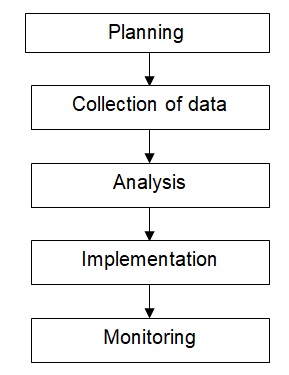Introduction
It is necessary to mention that the role of benchmarking in many industries has been rapidly increasing over the years, and a broad range of techniques and approaches are currently available. Some of them vary in effectiveness, but the overall process is rather similar. It would be appropriate to review and analyze peer-reviewed articles and books on this subject matter to determine which strategies are the most important, and combine the knowledge to propose a new program that should be considered by the firm.
Discussion
It is necessary to understand that benchmarking may be used to measure a variety of factors that could affect the success of a company. Most enterprises devote the most attention to performance levels of employees (Zhu 154). The utilization of modern technologies is incredibly important in this case because it will help to minimize unnecessary expenses. The problem is that some companies are not likely to share the information and it is necessary to reach an agreement (Wireman 95). Therefore, internal metric benchmarking is an approach that has been selected in this case because its effectiveness, but an understanding of organizational objectives is required (Lake 85). A broad range of software programs are available on the market, and the organization should select the one that fits its current objectives. A company may be interested in only several indicators at the start, but it would be beneficial to utilize at least 15 metrics because it will be possible to determine relationships and correlations between particular variables. Therefore, it will be possible to facilitate change within an organization and promote growth. The benchmarking process should consist of several crucial steps (see Figure 1).

Implementation should be regarded the most important step because it requires dramatic changes in the organization. An action plan should be developed, and its objectives can be aligned with benchmarking to maximize effectiveness. Higher-ups must acknowledge the fact that benchmarking can be inefficient if an individual responsible for monitoring is not qualified and lacks experience. Systematic assessments are critical and must be utilized to determine possible weaknesses and limitations. A trained professional must assimilate the information to determine if the progress shown is statistically significant and consider adjustments that would focus on other areas. Employees may use benchmarking to improve the performance of a particular department if they have access to the necessary data about the productivity of others (Owusu-Yeboah 81). A framework selected will consist of twelve steps, and the same approach should be utilized in case a problematic area has been identified (see Table 1).
Tab. 1. Benchmarking framework.
An organization may skip some stages, but the success of the process is not guaranteed in such cases. It is reasonable not to punish individuals that show worse results at the start because performance levels and expectations are not clear. However, benchmarking is commonly used to track of various variables. Therefore, it would be much easier for workers to understand which areas are the most problematic and must be addressed if they have access to such information. The implementation may take at least several months, and a specialist should analyze available data to make required adjustments and maximize its effectiveness. A management team must understand that some weaknesses cannot be avoided, and requirements must be reasonable. Another benefit of the proposed methodology is that it is much easier to change indicators if software programs are used because it is possible to alter the formulas and relationships between some of the variables.
It is paramount to consider the experience of biggest enterprises all over the globe. For instance, it is suggested that benchmarking in such countries as China can be supported through intergovernmental collaborations in some industries. A competitive approach is viewed as one of the most efficient, and it includes the data collected from other firms. Multinational organizations may apply benchmarking to analyze its performance in different regions, and alter the strategy depending on the findings (Zairi and Leonard 25). Moreover, it will be much easier to make financial projections if an enterprise may determine if performance standards can be reached or not.
Conclusion
In summary, it is possible to state that the proposed benchmarking program is expected to be incredibly efficient because it was based on techniques that have proven to be effective. Moreover, the method is rather flexible, and a firm may alter some of the processes depending on the situation. A combination of benchmarking and cost estimation is particularly beneficial because it helps to avoid unnecessary expenses (Trendowicz 15). Overall, it is imperative not to overlook the importance of benchmarking and a well-developed program has a tremendous impact on the profitability of a firm.
Works Cited
Lake, Neville. The Strategic Planning Workbook. 3rd ed. 2012. London, UK: Kogan Page Publishers. Print.
Owusu-Yeboah, Samuel. “Benchmarking in practice.” Economics, Management, and Financial Markets 4.3 (2010): 81-86. Print.
Trendowicz, Adam. Software Cost Estimation, Benchmarking, and Risk Assessment: The Software Decision-Makers’ Guide to Predictable Software Development, New York, NY: Springer Science & Business Media, 2013. Print.
Wireman, Terry. Benchmarking Best Practices for Maintenance, Reliability and Asset Management. 3rd ed. 2014. Norwalk, CT: Industrial Press. Print.
Zairi, Mohamed, and Paul Leonard. Practical Benchmarking: The Complete Guide, Berlin, DE: IDP Education Australia, 2011. Print.
Zhu, Joe. Quantitative Models for Performance Evaluation and Benchmarking: Data Envelopment Analysis with Spreadsheets. 3rd ed. 2014. New York, NY: Springer Science & Business Media. Print.